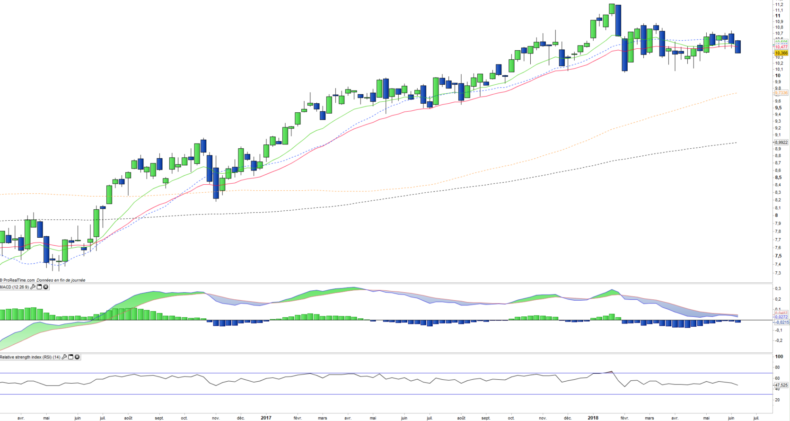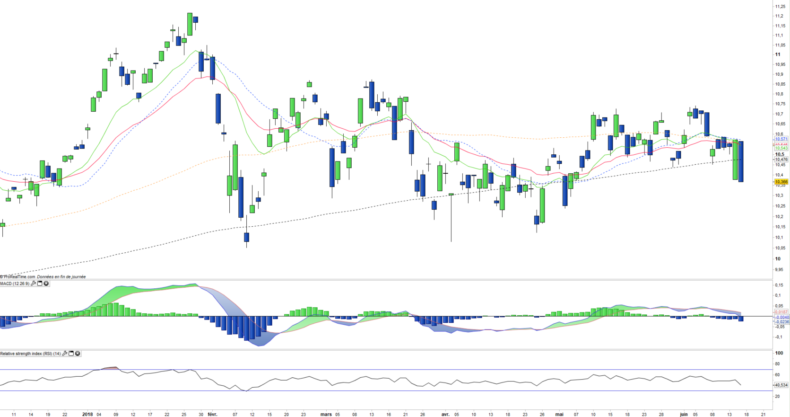Lyxor Emerging Markets (LEM) - 18/06/2018
Short Term strategy: Negative (30%) / Trend -
Long Term strategy: Positive (80%) / Trend -
Characteristics of the ETF
The Lyxor LEM ETF (UCITS), created in 04/2007 in Euro on Euronext and replicates the MSCI Emerging Markets Net Total Return Index. The values of the MSCI Emerging Markets Net Total Return Index are selected to represent 85% of the market capitalization of the Emerging Markets zone, while reflecting the economic diversity of this market.
It is a global index of 1141 stocks, with 26% of the capitalization coming from China.
The fee of this ETF is 0.55% and the AUM is approximately € 1658M. The replication method is indirect (via a swap) and there is a dividend capitalization method.
Alternative ETFs: EEM (iShares in USD), EMEA (Amundi in EURO)
Index & components
The ETF LEM replicates a broad index composed of 1141 stocks from 28 countries.
The most represented zone is Asia with 70% of the capitalization of the index of which 29% for China, 15% for South Korea and 8.4% for India. The major South American (including Brazil: 5.6%), African (including South Africa: 6.1%) and Middle Eastern economies are represented in the index by market capitalization.
The two main sectors are technology (29% of the index) and financials (23%).
The top 10 stocks in the index represent only 25% of the index's capitalization (Tencent is the first capitalization with 5.4%) and the specific risk is therefore quite low.
Emerging countries may be correlated in their stock market evolution, however there are also opposite rationales. For example, a good number of African countries, the Middle East or South America are linked to oil prices while India has an inverse correlation because it exports almost all of its energy. Global growth is now led by emerging countries, which account for nearly 40% of global GDP, with India (7% growth) and China (6%) leading the way. These two emerging giants will be 5th and 2nd world economies in 2018. Next to these two major economies, which together account for 40% of the world's population, a number of major emerging economies such as Brazil, Turkey or Mexico have more chaotic paths because of political problems (Turkey, Brazil) or specific problems, like Mexico in full negotiation with the US on trade agreements.
Emerging countries are much stronger financially and economically than they were 20 years ago during the 1998 crisis, and often have lower debt and smaller fiscal imbalances than developed countries due to less generous social systems and more dynamic demography.
Latest developments
In 2017, the index achieved a performance of 20.9% and after a favorable start in January is down about 1 .5% in 2018 due to a number of internal and exogenous factors.
The first factor of the decline is political, and primarily affects Latin America (Brazil, Colombia and Mexico in particular), because of high-risk political elections that could threaten the fragile economic recovery.
Turkey is in the same situation while President Erdogan has a policy of less and less liberal, while South Africa is also riddled with corruption. In these countries, the decline in the index occurs mainly by the currency but also by the banks.
The major emerging Asian economies (India, China and Indonesia) are in turn threatened by two exogenous phenomena that are rising oil prices, while these countries are net importers, and the increasingly protectionist trade policy of the US which threatens global growth, and has the effect of driving up the dollar and interest rates, causing capital flight to the United States, which in turn should fuel inflation.
Weekly data
The weekly chart shows a corrective movement that is likely to turn into a medium-term reversal. EMA13 and 26 threaten to turn around, while the false crossover of the MACD is a negative factor, especially as the zero line gets closer. A downward acceleration from these levels is possible, it would have for primary objective the EMA100 located towards 9.8 €
Daily data
The daily chart shows a deterioration in the technical structure that fails to form a credible rebound since the rise of early 2018. Prices are positioned on the EMA200 which threatens to give way after the formation of a negative candlestick Friday latest. The EMA200 is the main support for the index, which has been regularly tested since the beginning of the year. Its break would confirm a reversal of trend in the medium term.
ETF Objective
LEM is a UCITS ETF, listed in €, which seeks to replicate the MSCI Emerging Markets Net Total Return index (1141 emerging countries companies)
Characteristics
| Inception date | 18/04/2007 |
| Issuer | Lyxor |
| Expense ratio | 0,55% |
| Benchmark | MSCI Emerging Markets Net Total Return index |
| Ticker | LEM |
| ISIN | FR0010429068 |
| UCITS | Yes |
| EU-SD Status | Out of scope |
| Currency | € |
| Exchange | Euronext Paris |
| Assets Under Management | 1 658 M€ |
| Replication Method | indirect (swap) |
| Dividend | Capitalization |
| PEA (France) | No |
| SRD (France) | Yes |
| Currency risk | Yes |
| Number of holdings | 1 141 |
| Risk | 4/5 |
Country Breakdown
| China | 29% |
| South Korea | 15% |
| Taiwan | 12% |
| India | 8% |
| Brazil | 6% |
| South Africa | 6% |
| Others | 24% |
Sector Breakdown
| Information Technology | 29% |
| Financials | 23% |
| Consumer discretionary | 9% |
| Materials | 8% |
| Energy | 7% |
| Consumer Staples | 6% |
| Industrials | 5% |
| Others | 13% |
Top Ten Holdings
| Tencent | 5% |
| Samsung Electronics | 4% |
| Alibaba Group | 4% |
| Taiwan semiconductor | 3% |
| Naspers | 2% |
| China Construction Bank | 2% |
| Baidu | 1% |
| Ind & Comm Bank of China | 1% |
| China Mobile | 1% |
| Ping an Insurance Group | 1% |


